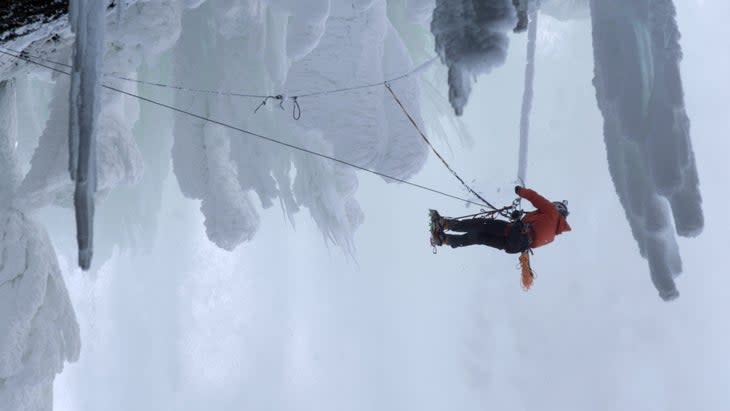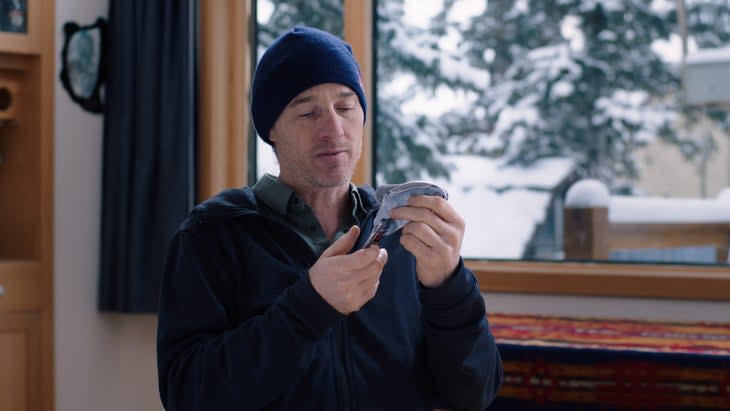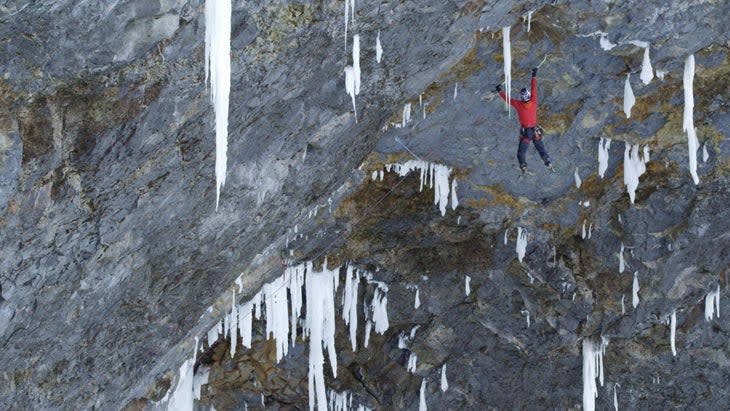Interview: Will Gadd on Making a Near-Fatal Gear Mistake
- Oops!Something went wrong.Please try again later.
This article originally appeared on Climbing
In February 2014, while equipping what would later become Overhead Hazard, a 200-meter (650-foot) M13+ at Helmcken Falls in British Columbia, Will Gadd, one of the world's best ice and mixed climbers, made a mistake that nearly killed him.
Climbing at Helmcken Falls takes a rarified combination of skill, pain tolerance, and environment-specific expertise. The cave is huge and steep, the rock is friable, and the waterfall coats everything (the rock, your ropes, you) with fast-freezing mist. Thanks to constant ice buildup, Gadd and his team struggled with rope vibrations, which kept shaking open the screw-gate carabiners they used on their Grigris.

Gadd's mistake?
Before rappelling down from the top of the cave to bolt the final pitches, he gave his personal Grigri and carabiner--a triple locker--to a member of the film crew, rationalizing that, as a professional mountain athlete, he was better equipped to manage the risk.
"Obviously that was not true," Gadd said in our interview.
It was -22 degrees Fahrenheit, and even though Gadd was wearing an awkwardly thick number of layers, he found himself, after hours of cleaning loose rock and placing bolts, turned into a "human icicle" by the spray. He then had to rappel the rest of the severely overhanging wall, a laborious process that involved rapping the length of a rope, jumaring back up to the next lowering anchor, and then rapping again, all while cleaning ice off the ropes.
During that process, he forgot to monitor the borrowed screw-gate carabiner, which came unlocked, then got stuck open. When he looked down, he found that his Grigri was resting in the nose of an open carabiner--and the only thing separating his life from his death was "an eighth of an inch of carabiner gate."

A disclaimer
Now I should note here that "The Edge of the Unknown with Jimmy Chin" is not designed for the climber audience. The show is short on the sort of specifics that make incidents like Gadd's especially interesting, and it's long on the kind of inaccuracies and partial truths common to non-climber portrayals of the sport. To keep the overstimulated TV viewer from touching their remotes during the ads, the show repeatedly portrays quotidian perils as dangerous and highly dramatic--like the fall (onto a bolt) that Gadd takes on Overhead Hazard's fourth pitch during his ground-up redpoint attempt. But at the same time the show largely ignores the more technical aspects of the climb (there's no pitch by pitch breakdown) and the main danger of climbing in Helmcken: the falling ice and rock for which Overhead Hazard is named.
But the climbing footage is excellent. And Gadd's willingness to speak about his near-fatal accident and its effect on him is powerful and important. So I sat down with him (over Zoom) to chat about his episode, about climbing at Helmcken Falls, and about why even professional climbers need to continually remind themselves that they're capable of making dumb mistakes.
THE INTERVIEW
Climbing: One thing I really respect about Chin's "The Edge of the Unknown" series is that we see athletes from different disciplines exposed to a common source of error: themselves. One episode is about Travis Rice, the snowboarder, getting caught in an avalanche that he could have avoided. He was overconfident; he was stressed about the film crew and the weather window; so he went for a line he'd have avoided if he'd conducted the simplest snow test. And afterwards he felt super embarrassed about the mistake. It threatened his confidence. You had a similar experience, right?
Gadd: Shit happens. I've been climbing for 40 years, and every day I go out the door with the expectation that I could do something new and different. You can say it's stupid, but it's the human condition: We all make mistakes. You never set out on a climbing day to do some stupid shit and have an accident, but sometimes that's what happens. It doesn't matter how long you've been climbing or how good your systems are. We make mistakes. And we need to try to remove some of the embarrassment from that. We have to talk about these things, to remove the expectation of perfection, the idea that if you're not perfect you're an idiot. It's totally unrealistic.
Ed note: Travis Rice’s episode also drops on the 13th.

Climbing: I think a lot of our Facebook audience tends to assume that people who have accidents are somehow foolish or dumb newbs. But John Long and Lynn Hill forgot to tie their knots. I rapped off my rope. Brad Gobright rapped off his rope.
Gadd: Rather than hearing about an accident and saying, "You're stupid, I will never make that mistake," which is how I treated accidents early in my career, now I'm like, "I've done that." Most climbers have made stupid mistakes at some point in our career and gotten away with it. I know I have. But when you get away with it, you're like "Oh, that was the result of good judgment." But the reality is that you got away with it.
I think we need to demystify accidents. Sharing these mistakes and errors helps people talk more about them and reminds people that we're going into this high-hazard environment and that we have to do our best to be safe. I do a lot of work in an industrial safety environment. And in the good companies you don't get fired if you have an incident or an accident. You get fired if you don't report it and broadcast it and share the learning with everyone else in the company. I would like to see that same sort of thinking happen in climbing. Let's talk about this and see what we can learn so we can collectively do better. Let's try to change the culture a bit. Let's start the "I fucked up and lived" society. Most people have had an experience or are going to.
Climbing: A lot of time there seem to be multiple factors that cause mistakes. The main drama of your episode is the Grigri or carabiner error. Can you walk me through it?
Gadd: In my situation, it's minus 30 [Celsuis], I'm wearing a lot of clothes, I've actually given my normal triple locker to a guy on the film crew because we'd all been having issues with the vibrations, and I was like, "Oh, I do this professionally, I'll manage this better than you do." And obviously that was not true. All these things came together and suddenly I was hanging off an eighth of an inch of carabiner gate. I got lucky.
Climbing: Was the correction process something you were inching your way through or was it a manic reaction?
Gadd: It was pretty manic. But it was calculated. I was like, "I have to do something here." But everything was covered with ice. I wasn't totally sure what kind of carabiner it was or how firmly it was latched there. So I kind of just went gurr-man on it and yoinked myself. And it worked. Again, hindsight is 20-20. There's probably a more elegant way to solve it. But I solved it.
Climbing: You've constantly been innovating throughout your career. What did the Helmcken Cave mean for you and your climbing?
Gadd: When Tim Emmett and I first walked into that cave fifteen years ago, we thought it was both heaven and hell. It was the coolest place ever but what could you do with it? How could you climb it? It made no sense. We had to chip away at it and learn new systems. At the time, I saw the line of Overhead Hazard and I was like, Someday someone is going to climb that thing. But I never thought it would be me. Eventually we learned enough to make it, if not safe, at least not completely batshit. For me that is for sure the hardest mixed line I will ever do, under the toughest conditions.
Climbing: How does it compare to the alpine environments you've climbed in?
Gadd: I would look at Helmcken as very much alpine climbing. You can't make it remotely safe. It's cold. And you've got this mist that blows around pretty randomly, so one moment you're fine and the next your ropes ice up and you're trying to descend a rope that literally has two inches of ice on it. And it's all overhanging. So even just to rappel the wall is quite complicated. You have to rappel down to the end of the rope, switch over to your ascenders, climb back up to the re-belay. So just getting out of there from four pitches up takes an hour. If you hurt yourself, you've got to be with the right people and it's going to take them a long time to get you down. There's very minimal technical mountain rescue in that area. So it's very much an alpine environment with very technical climbing. It was really magical for us. But occasionally someone is like, you want to go back? And I'm like, You know, I don't know. One thing I wished I'd told my younger self is that not all forms of climbing are the same. These environments are wildly variable, and the inherent hazards in alpine climbing are way higher. I try to spend less time in those environments these days. But the climbing is so cool. And for me it was a big leap forward.
Climbing: Anything else you want to add?
Gadd: The only reason that line happened was the team. We went down there every day together. It was ridiculous. It was minus 30. We were trying to make a film at the same time. If there was anything I'd like to see emphasized more [in the film] it was the team element. There was a form of collective madness down there.
For exclusive access to all of our fitness, gear, adventure, and travel stories, plus discounts on trips, events, and gear, sign up for Outside+ today.

